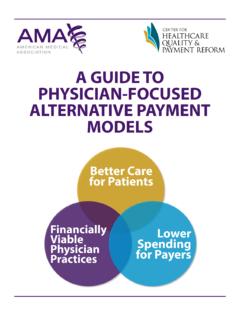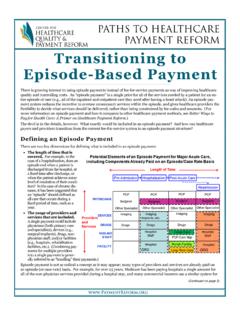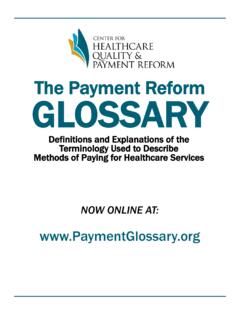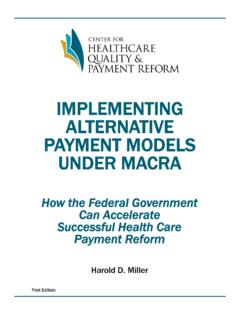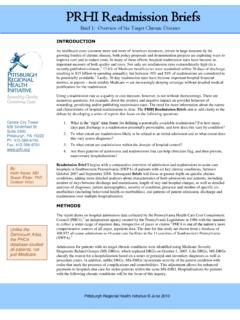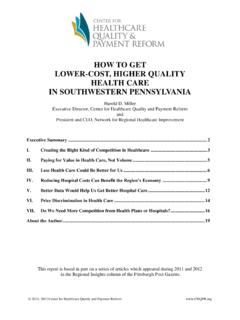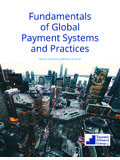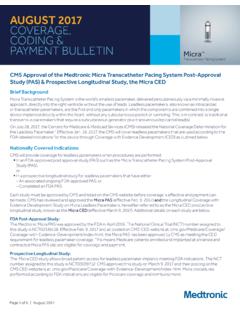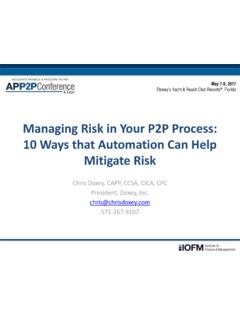Transcription of PATHS TO HEALTHCARE PAYMENT REFORM …
1 PATHS TO HEALTHCARE . PAYMENT REFORM . Which HEALTHCARE PAYMENT System is Best? There is broad agreement that significant reforms are needed to the Fee-for-Service PAYMENT systems that are commonly used today, since they give HEALTHCARE providers strong financial incentives to deliver more services to more people, but often financially penalize providers for delivering better services and improving health. The two major alternative pay- ment systems currently being discussed are: Episode PAYMENT , , paying a single price for all of the HEALTHCARE services needed by a patient for an entire episode of care ( , all of the inpatient and outpatient care they need after having a heart attack); and Comprehensive Care PAYMENT (also called condition-adjusted capitation, or risk-adjusted global fees), , paying a single price for all of the services needed by a specific group of people for a fixed period of time ( , all of the care needed during the course of a year by the people who work for a particular employer or by people who have chronic diseases).
2 (For more information on different HEALTHCARE PAYMENT methods, see Better Ways to Pay for Health Care: A Primer on HEALTHCARE PAYMENT REFORM .). Trying to weigh the pros & cons and pick the best PAYMENT method is a flawed approach, particularly at this very early stage of HEALTHCARE REFORM . Episode payments are better for certain kinds of conditions and patients, and Comprehen- sive Care payments are better for other kinds of conditions and patients, and the best approach is probably using a com- bination of both. When they should be used depends on the characteristics of the cost and quality problems to be solved. Two Different Kinds of Cost/Quality Problems to be Solved There are (at least) two different reasons why the cost of treating people with a particular condition may be higher than it needs to be: 1. The cost of an episode of care for a particular condition is unnecessarily high and/or there is high varia- tion in the cost and quality of episodes among similar patients and across regions.
3 For example, the cost of an uncomplicated labor and delivery for a pregnant woman varies dramatically across the country, depending on the rate at which birthing centers or hospitals are used, how frequently labor is induced before 39 weeks gestation, how frequently Cesarean sections are used, etc. Also, pro- grams that report on both hospital costs and Different PAYMENT Systems Solve Different Cost/Quality Problems quality show wide variations in the costs of common surgeries from hospital to hospital, Episode PAYMENT Comprehensive Care Pmt. even after adjusting for case severity and High +. Episode PAYMENT outcomes. 2. Episodes occur more frequently than Examples: Examples: necessary for a particular condition Amount/ Hip Fractures, Heart Disease, and/or the frequency of episodes var- Variation Labor & Delivery Back Pain ies significantly among similar pa- of tients and across regions.
4 For example, Cost Fee for Service Comprehensive Care Pmt. the type of care that chronic disease patients Per (or Year-Long Episodes). receive in the community can significantly Episode affect the rate at which they are hospitalized Examples: Examples: for exacerbations of their illnesses. Also, Immunizations, COPD, research by the Dartmouth Atlas project has Low Simple Injuries Congestive Heart Failure shown wide variations in the frequency of cardiac surgery and other types of proce- dures across the country, with no evidence Low High that higher frequencies achieve better out- Size/Variation in Frequency of Episodes Per Condition comes for patients. (Continued on page 2). Which HEALTHCARE PAYMENT System is Best? Page 2. (Continued from page 1). When to Use Episode payments The strength of Episode PAYMENT is reducing cost and variation within episodes. For example, using Episode payments for uncomplicated labor and delivery could encourage use of the most cost-effective settings, and could discourage elec- tive early inductions and Cesarean sections that can cause harm to the child and the mother.
5 Similarly, using Episode payments for orthopedic surgery could encourage surgeons to agree on reducing the number of types of prostheses used, thereby enabling more cost-effective purchasing by the hospital. However, Episode PAYMENT does nothing to dis- courage unnecessarily high numbers of episodes of care among patients with a particular condition. When to Use Comprehensive Care payments Although Comprehensive Care PAYMENT can also encourage lower intra-episode costs, its real strength is reducing the number of unnecessary episodes of care for a particular condition or group of people, so it makes sense to use this pay- ment method where there is concern about overuse of procedures or a high rate of preventable hospitalizations. For example, it makes sense to develop Comprehensive Care payments for patients with chronic disease, with a goal of pay- ing for services that help them to manage their conditions effectively and stay out of the hospital.
6 (An annual Compre- hensive Care PAYMENT for chronic disease patients can also be thought of as a PAYMENT for a year-long episode of care, . as Prometheus PAYMENT , Inc. has proposed.). When to Use Both Types of payments Although it may sound confusing to say that both types of PAYMENT should be used for some patients, this is no different that what is done in other industries through the process of contracting and subcontracting for work. For example, a primary care practice might contract to provide comprehensive care (everything from outpatient care to hospitalization) for a population of indi- COMPREHENSIVE CARE PAYMENT . viduals with heart disease, and be paid for that through a Comprehensive Care PAYMENT for each individual. If one of those individuals needed to be hospital- EPISODE. ized, the practice could make an Episode PAYMENT to a hospital and its physi- PAYMENT .
7 Cians to provide efficient, quality care during and immediately following the hospitalization. This combination approach makes the most sense where there Hospitalization is high variation in the rate at which episodes occur and there is also high varia- tion in the cost of those episodes when they do occur; for example, for patients Outpatient Care Monitoring with heart disease, there are opportunities to reduce the rate at which they have (Medical Home). heart surgery and to reduce the cost of surgery when it is needed. Medication When to Use Fee for Service Should Fee-for-Service PAYMENT be eliminated entirely? Where the principal or sole problem is underuse of a service, then Fee-for-Service PAYMENT actually can be the best approach to ensuring that patients receive that service (assuming that the fee level is adequate). If the total cost of the services needed for an episode of care is relatively low, there is lit- tle to be saved even if an Episode PAYMENT could be defined for those services.
8 At the other extreme, for conditions that are rare, difficult to diagnose, etc., even though the costs of individual episodes may be high, the challenges of defining Episode payments for them or of making providers responsible for these services under a Comprehensive Care PAYMENT may outweigh any benefits that could be achieved. Is a Mixed PAYMENT System Feasible? Using multiple PAYMENT methods is actually more similar to current PAYMENT structures than using a single new approach for everything. Although most services today are paid for on a Fee-for-Service basis, many are paid on some form of Episode PAYMENT or capitation. For example, Medicare has paid for hospital services on a partial episode basis for over 25 years through the DRG 320 Ft. Duquesne Blvd., Suite 20-J. system. Some physicians, such as surgeons and obstetricians, are paid today Pittsburgh, PA 15222.
9 On a case rate basis while others are paid fees for individual services. Some VOICE: (412) 803-3650. providers receive capitation payments for some patients, while others do not. FAX: (412) 803-3651. The goal should be to pay for care of each condition in the right way, not nec- EMAIL: essarily the same way for all conditions.
